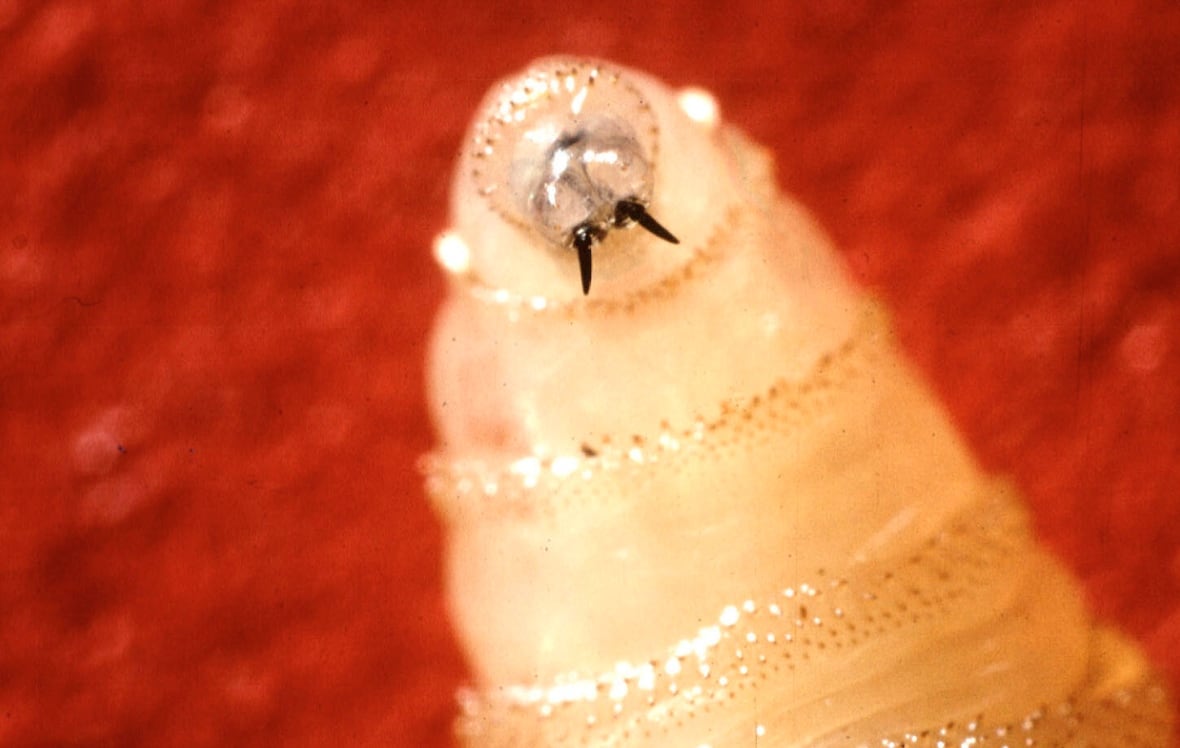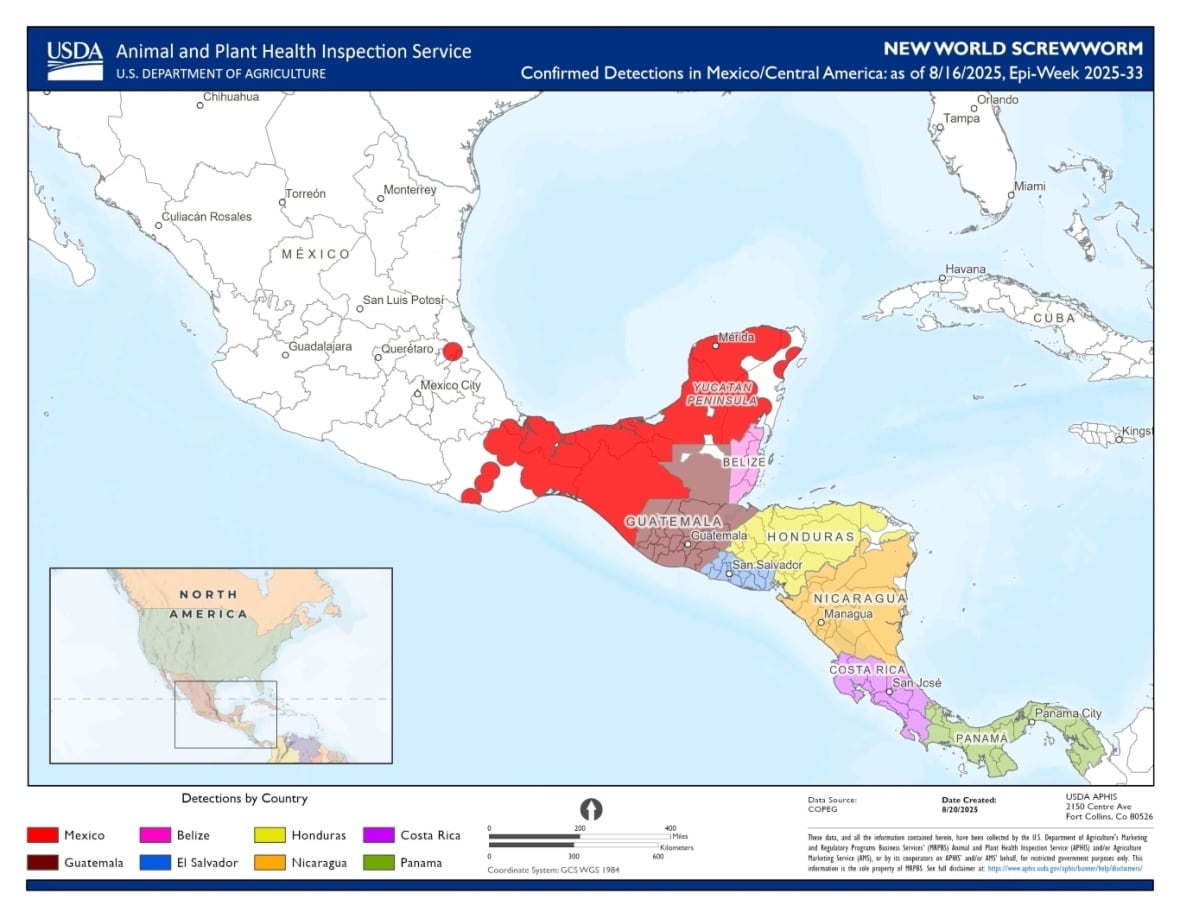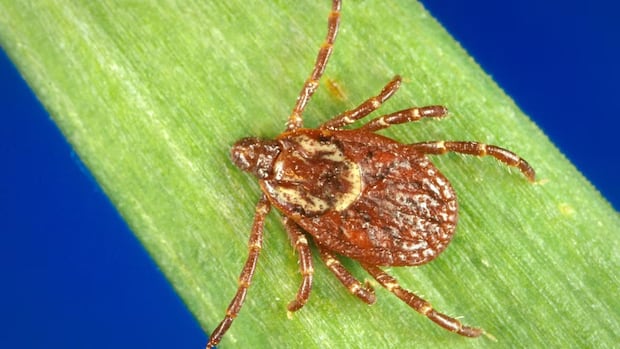Warning: This story contains images of an open wound that some people may find disturbing.
Just when you thought there was enough going on in the world to frazzle your nerves, along comes a flesh-eating parasite that has been spreading among livestock in Central America and has now infected a recent traveller from the United States and another from Canada.
It’s called the New World screwworm, and it burrows its way into the skin of a living animal host — like a screw — and feeds on tissue.
But we said you don’t have to freak out.
Human cases of infestations are incredibly rare, including when it comes to travellers to affected areas, and it’s not passed from person to person. But the worms are a menace to cattle ranchers, and an outbreak in Central America and Mexico is growing at a pace that has farmers across the region and in the U.S. concerned.
Here’s what we know about the the parasite, the two human cases and what can be done to control it.
Health officials in the U.S. are worried that New World screwworm — a flesh-eating parasite that typically feeds off livestock — could be making a comeback in North America after a rare human case was identified in Maryland.
What is the New World screwworm?
The U.S. Centers for Disease Control and Prevention confirmed on Aug. 4 that a man from Maryland had the country’s first human case of a New World screwworm infestation connected to the recent outbreak.
He had recently travelled to El Salvador, which is one of the affected countries, and has since recovered.
The parasite is the larvae of the New World screwworm fly.
The female fly lays its eggs on warm-blooded animals — often in an open wound or scratch in the skin but sometimes in the mucous membranes of the nose, eyes or mouth.
The larvae — or what we would commonly refer to as maggots — hatch and then eat their way into the host’s flesh.
This type of parasitic infestation is known as myiasis, which is common and generally not dangerous, said Dr. Michael Libman, an infectious diseases specialist at Montreal’s McGill University Health Centre.
“There’s a whole bunch of types of flies that are capable of doing this, and most of them are benign,” he told CBC News.
Libman said myiasis is commonly seen in pets, as well as in people who have open wounds and are living in unhygienic situations, but it’s easily treated and has few implications.
What makes the New World screwworm different, he said, is that it’s “much more aggressive,” and they “actually feed on living skin.”
(Its scientific name, by the way, is Cochliomyia hominivorax; hominivorax literally means “man-eater.”)

Screwworm infestations can cause ulcerated lesions that don’t heal and give off foul-smelling odours, infections and possibly death (mostly in animals).
Although it is extremely rare among the already small number of human cases, there was a fatality documented in Costa Rica in 2024 — the first in that country since the 1990s — in a person who had been living with a disability.
The six other people in the country who were infected that year all recovered.
Quebec has reported a case of the potentially deadly tick-borne disease Rocky Mountain spotted fever. Infectious diseases specialist Dr. Isaac Bogoch says the infection is rare but can be deadly. It is easily treatable with antibiotics, he says, but prevention is key.
How is it treated?
It’s a “straightforward” treatment to get rid of an infestation, said Dr. Isaac Bogoch, an infectious diseases specialist at Toronto General Hospital: You have to pull the larvae out of the tissue.
But because they can burrow deep into the flesh, and there can be “tens or even hundreds of larvae underneath,” he said, surgery is sometimes required.
That’s what happened earlier this year to a Canadian man in his 80s. He had fallen while hiking down a steep hill during a trip to Costa Rica and had abrasions on his knees and shins. But about a week later, an ulcer remained on his right shin.
According to a study on his case, co-authored by Bogoch and published in a recent issue of Travel Medicine and Infectious Disease, doctors in Costa Rica removed 30 to 40 larvae from the ulcer before advising him to get medical attention at a larger medical facility.
He flew to Toronto, where doctors had to extend an incision to remove even more larvae, which were later confirmed to be New World screwworms. A scan showed there was no further damage deeper in his tissue. He was given a tetanus shot and released with a dressed wound.

Can you prevent this from happening?
Bogoch told CBC News Network that while there is an extremely low risk to travellers, it’s “not zero per cent.”
He said that that if you’re visiting one of the countries with an outbreak — which extends from Panama to Mexico — and come back with symptoms, you should inform your physician.
“That also means that health-care providers need to be aware of [it and] other travel-associated illnesses,” Bogoch said.

But it’s not something that should make you reconsider travelling to popular holiday destinations in Central America, Libman said.
He said basic precautions, similar to what you would take when trying to protect yourself from mosquitoes and other insects in tropical climates, should help keep the New World screwworm flies away — if you’re even anywhere near them.
Human cases are uncommon. Why do we care?
Libman stressed that the bigger concern is for livestock, cattle in particular. Infections can be “very damaging” to the animals and cause significant losses for farmers, he said, as some countries restrict imports from affected areas in order to limit the spread of screwworms.
New World screwworms were largely eliminated in the southern U.S. in the 1960s, Mexico in the 1970s and Central America by the early 2000s.
Libman explained that male flies that had been sterilized through irradiation were released by the millions, leading to females not producing offspring when they mated.
He said it’s “truly remarkable” that this method managed to control the problem for decades without using pesticides.

Libman said it’s not clear what led to the recent resurgence in Central America, where it was first detected in 2023 and grew into a regional outbreak in the following years.
But he said he believes it could become harder to manage the spread if the flies continue to move into larger areas, where it would be harder to mount such a widespread effort to control them.
The Canadian Food Inspection Agency says it’s monitoring the outbreak in Mexico and Central America and notes that the New World screwworm is not present in Canada and could not survive the country’s winter temperatures.
Dr. Samir Gupta, a Toronto-based respirologist, is warning of an increase in tick bites and tick-borne illnesses across Canada. Ticks are parasites that feed on the blood of wild animals and are known to transmit bacteria through bites.








